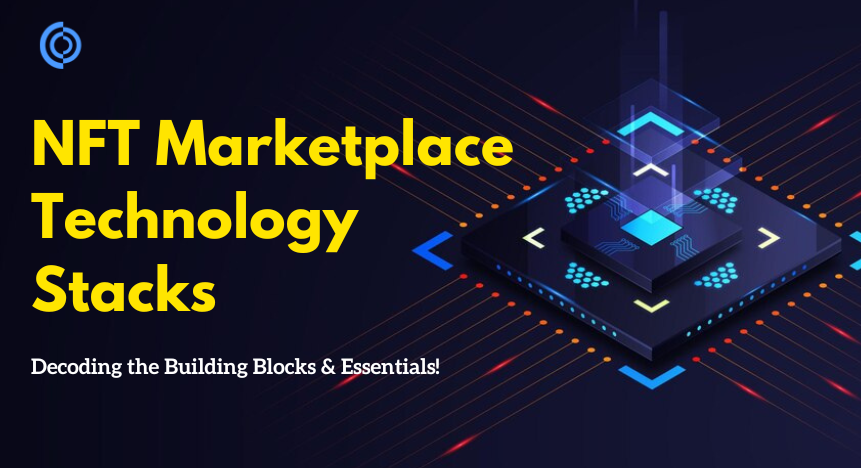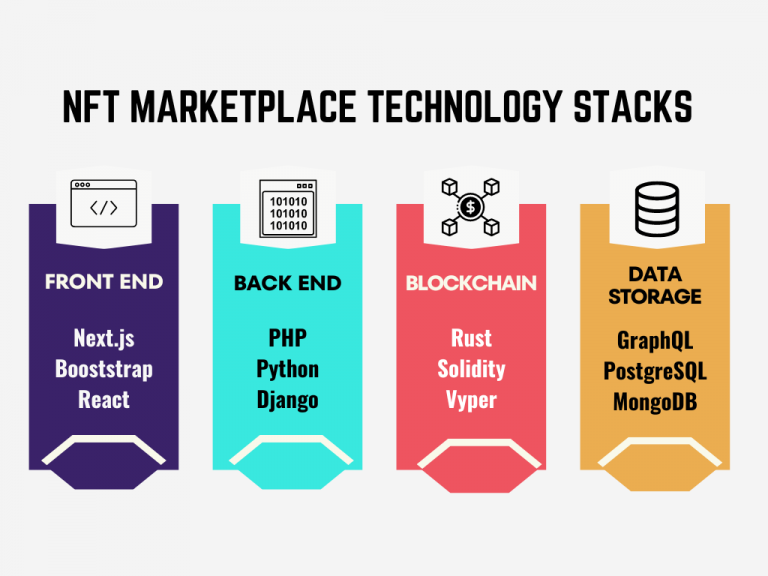The NFT Marketplace is a vibrant place for businesses and NFT enthusiasts to live and explore. It’s like entering a vibrant place where each click opens the door to a unique digital wonder. According to statistics, the average revenue of a single user in the NFT market in 2024 will reach US$138.80, and the revenue of the NFT marketplace will be US$2.378 billion Until the end of 2024.
Creating such a digital revolution is not that easy. NFT marketplace development requires many technologies. The ultimate gamer that turns ideas into reality, transactions into experiences, and the ordinary into the extraordinary is the technology stack. When considering developing an NFT marketplace, you should also be aware of the best technology stack required to build an NFT platform. Let’s learn about the game changer – “NFT Marketplace Technology Stack” Details here! Before that, let me tell you the basics…
NFT Marketplace Overview
NFT Marketplace is a digital platform that makes it easy to sell or buy non-fungible tokens (NFTs). These tokens are purchased or auctioned at a predetermined price. To utilize this marketplace, you will need a cryptocurrency wallet to make transactions or store tokens. Users can create an account and post digital artwork to sell on the NFT marketplace. You can have many different categories in one place. There are many different categories you can list on your NFT marketplace. in other words:
- digital art work
- digital collectibles
- NFT art app
- Unique dress/handbag
- In-Game Collectibles
- music track
- Essay/Creative Writing.
This NFT marketplace allows artists and creators to tokenize their works, providing secure and verifiable proof of ownership. This allows creators to monetize their digital creations directly and eliminates the need for traditional intermediaries. NFT marketplaces therefore clearly demonstrate the potential of blockchain technology to reshape how we create, buy, and sell unique digital assets.
Also read: How to Build an NFT Marketplace Platform
I know about this. Gain in-depth knowledge about building blocks! NFT Marketplace Technology StackBrings them to life.
The Best NFT Marketplace Technology Stacks to Watch
A technology stack is a combination of programming coding languages, databases, frameworks, and tools used to build an application platform. The NFT marketplace technology stack determines the scalability, security, and overall performance of the platform. The success of the platform is based on the technology stack involved in the development process. they.
front-end framework
A front-end framework is nothing more than what users see when they enter a website page. Buttons, checkboxes, graphics, and text are all front-end development. Popular frontend frameworks include:
Next.js – One of the popular server-side rendering frameworks is Next.js. A framework for React that developers can use in any application. Next.js has built-in features like automatic code splitting and optimized performance to help developers easily create scalable, high-performance web applications.
Bootstrap – Open source front-end frameworks used for developing responsive, mobile-first projects on the web include: bootstrap. It creates sophisticated patterns based on CSS and JavaScript that provide formatting for terrain, formulas, buttons, navigation, and additional interface components. An important use of Bootstrap is that it simplifies the mechanism of creating responsive web applications that work well on both desktops and mobile phones.
react – react It is a JavaScript library. The main goal is to build a highly attractive user interface for single page applications. It also guides the development of reusable user interface elements that can be integrated into a variety of application areas. It also allows you to manage complex UI, shortening development time.
backend framework
The backend framework is the data and infrastructure that makes your application work. Popular backend frameworks include:
PHP – Hypertext preprocessor. It is a widely used open source scripting language suitable for web development and can be embedded into HTML. Supports various types of databases, including MySQL, Oracle, and PostgreSQL.
Python – Python is a flexible, high-level programming language that can be used for web development, AI, and more. It has a huge collection of libraries and frameworks that make the development process easy and fast.
Django – It is an open source high-level Python-based programming language used for web frameworks. As follows MTV (Model – View Template), architectural patterns, etc. This framework supports rapid development and clean projection. Apps developed by Django are very secure.
blockchain
rust – Rust is a systems programming language that provides high memory comfort and improves performance while preventing errors. This rust quality is perfect for blockchain development. Rust is a development of a blockchain framework including smart contracts.
Robust – Solidity is a high-level programming language used for contracts on the Ethereum blockchain. It is equivalent to JavaScript and helps developers create decentralized apps on the Ethereum platform. It is very secure and has features such as contract inheritance and libraries that allow code reuse.
Viper – Viper is Python-based Ethereum Virtual Machine (EVM) Built to be more secure and auditable than Solidity. The coding syntax is very simple and has fewer features than Solidity, making the code easier to curate. Vyper is the best choice for developing simple and secure smart contracts.
Also read: Best Blockchain for Launching NFT Marketplace
data storage
GraphQL – A query language that helps you retrieve data from graph databases. This provides an efficient way to retrieve data and helps developers specify the specific data they want. This enables features like grabbing, batch processing, real-time updates, and more. These many features make it popular for building APIs.
PostgreSQL – This is the latest goal for relational database management strategies that support SQL Idioms. PostgreSQL is a highly stable and scalable database that processes large amounts of data. Provides JSON-like functionality. (JavaScript object notation) Storage, full-text search, and transaction support for building web applications.
MongoDB – MongoDB is designed to handle large amounts of unstructured data. It provides features such as automatic sharding, indexing, and replica sets that enable building real-time applications.
smart contract
Smart contracts play an important role in the development of NFT marketplaces. It is deployed on the blockchain to resolve disputes between two parties without any third-party involvement. Smart contracts are written in a robust programming language that is currently used as the core language of Ethereum and other private blockchains. It supports all data types in programming languages such as booleans, integers, strings, modifiers, arrays, etc. Rules and restrictions are built into the network code.
The code specifies the steps required to execute the contract when specified conditions are met. This code enters the blockchain network and is executed when conditions are positive. Once a contract is entered into the blockchain network, it cannot be altered or altered. The purpose of using smart contracts is based on three categories: they:
efficiency – Contracts are executed at high speed.
accuracy – No – there is a possibility of human error.
Immutability – It cannot be changed or altered.
Wallet integration
You cannot use the NFT platform without a wallet. Every NFT marketplace requires a wallet, which allows users to send and receive cryptocurrency assets in seconds. Wallet integration must be compatible with both iOS and Android platforms. This allows users to maintain ownership and control of their digital assets. Technical components and standards contribute to the smooth operation of the wallet. This allows users to access and display metadata when interacting with the NFT. MetaMask, Trust Wallet, Coinbase Wallet, etc. are examples of digital wallets in the NFT Marketplace.
Payment gateway integration
NFT marketplaces are where users trade digital assets. For this purpose, Payment Gateway has become more necessary these days. Using NFTs only helps with cryptocurrency-to-crypto transactions. Therefore, a payment gateway is a payment network that allows you to easily transfer cryptocurrencies. We support all virtual assets required for payment. Bitcoin, Ethereum, USDT, Matic, Cardano, Solana, And other cryptocurrencies. A global usage development for merchants trading cryptocurrency. Transaction fees are low and can be as low as zero.
Nowadays, more companies are starting to accept cryptocurrency payments, making it very common to use cryptocurrencies for online payments. Cryptocurrency payment gateways for NFT marketplaces provide special software tools to facilitate the cryptocurrency payment process. You can also integrate multi-currency crypto payment gateways such as: Bitpay, Coin Gate, Shopify Gateway.
Now you have the insight into the best NFT marketplace technology stack you need. To keep your NFT marketplace platform running smoothly, you need to know about the necessary features.
Features needed for NFT marketplace development
- registration – This is a key feature of NFT marketplaces, where users create an account to use the marketplace with just a few clicks.
- Creation and Management – The marketplace must have creation and management capabilities. Creators should be able to upload assets and mint NFTs.
- Store front – NFT marketplace stores are like online stores. Therefore, it must be attractive and easy for users to navigate.
- Search bar – This NFT marketplace feature allows users to easily search for the NFTs they want from music, video photos, art memes, game characters, and more.
- List – Listings on NFT marketplaces are an important feature that allows sellers to develop and send collectibles.
- filter – Search filters are one way to improve the buyer’s experience. In an NFT marketplace, users should have filter options to sort items by categories such as price, rarity, artist, etc.
- Purchases and Auctions – NFTs can be sold through auctions where users and buyers can bid on NFTs. This is another way to sell mechanisms on NFT marketplaces.
- Community Features – A vibrant NFT marketplace should have community features that allow users to connect, share, and learn from others. This includes forums, social media integration, user-generated content, and more.
- Push Alarm – Update and engage users with new and trending NFTs through notifications.
- Security measures – NFT marketplaces must be very safe for users to transact. Responsible for anti-hacking and other security services.
Adding these exciting features to your NFT marketplace will help keep users connected to transactions and keep them on your website longer. Now let’s look at where to actually implement these features…
Where should we build a tech-rich NFT marketplace?
As already said, the Technology Stack is a key component of the NFT market that provides scalability, security, and performance to the platform. Therefore, to create a successful venture in the NFT marketplace business, you need to choose the right company that can develop an NFT marketplace platform with a good technology stack. In that respect, Coin Clone Is it one of those professions? NFT Marketplace Development Company We develop an NFT marketplace platform with an excellent technology stack. Choosing to add our services is a one-stop solution for all your NFT marketplace development. More than 500 notable projects have been completed immediately and you can try free demo sessions for further understanding. A solid connection with us will help you achieve your goals and win in the cryptocurrency market.


